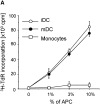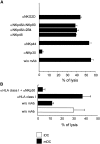Human dendritic cells activate resting natural killer (NK) cells and are recognized via the NKp30 receptor by activated NK cells
- PMID: 11828009
- PMCID: PMC2193591
- DOI: 10.1084/jem.20011149
Human dendritic cells activate resting natural killer (NK) cells and are recognized via the NKp30 receptor by activated NK cells
Abstract
During the innate response to many inflammatory and infectious stimuli, dendritic cells (DCs) undergo a differentiation process termed maturation. Mature DCs activate antigen-specific naive T cells. Here we show that both immature and mature DCs activate resting human natural killer (NK) cells. Within 1 wk the NK cells increase two-- to fourfold in numbers, start secreting interferon (IFN)-gamma, and acquire cytolytic activity against the classical NK target LCL721.221. The DC-activated NK cells then kill immature DCs efficiently, even though the latter express substantial levels of major histocompatibility complex (MHC) class I. Similar results are seen with interleukin (IL)-2--activated NK cell lines and clones, i.e., these NK cells kill and secrete IFN-gamma in response to immature DCs. Mature DCs are protected from activated NK lysis, but lysis takes place if the NK inhibitory signal is blocked by a human histocompatibility leukocyte antigen (HLA)-A,B,C--specific antibody. The NK activating signal mainly involves the NKp30 natural cytotoxicity receptor, and not the NKp46 or NKp44 receptor. However, both immature and mature DCs seem to use a NKp30 independent mechanism to act as potent stimulators for resting NK cells. We suggest that DCs are able to control directly the expansion of NK cells and that the lysis of immature DCs can regulate the afferent limb of innate and adaptive immunity.
Figures








References
-
- Banchereau, J., and R.M. Steinman. 1998. Dendritic cells and the control of immunity. Nature. 392:245–252. - PubMed
-
- Thery, C., and S. Amigorena. 2001. The cell biology of antigen presentation in dendritic cells. Curr. Opin. Immunol. 13:45–51. - PubMed
-
- Banchereau, J., F. Briere, C. Caux, J. Davoust, S. Lebecque, Y.J. Liu, B. Pulendran, and K. Palucka. 2000. Immunobiology of dendritic cells. Annu. Rev. Immunol. 18:767–811. - PubMed
-
- Ljunggren, H.G., and K. Karre. 1990. In search of the ‘missing self’: MHC molecules and NK cell recognition. Immunol. Today. 11:237–244. - PubMed
Publication types
MeSH terms
Substances
Grants and funding
LinkOut - more resources
Full Text Sources
Other Literature Sources
Research Materials

